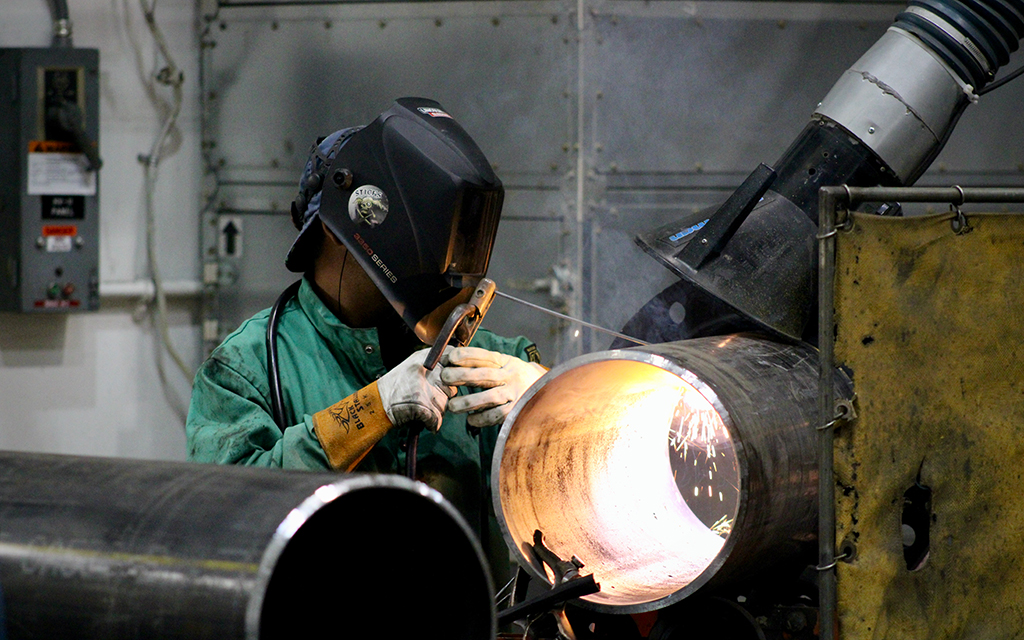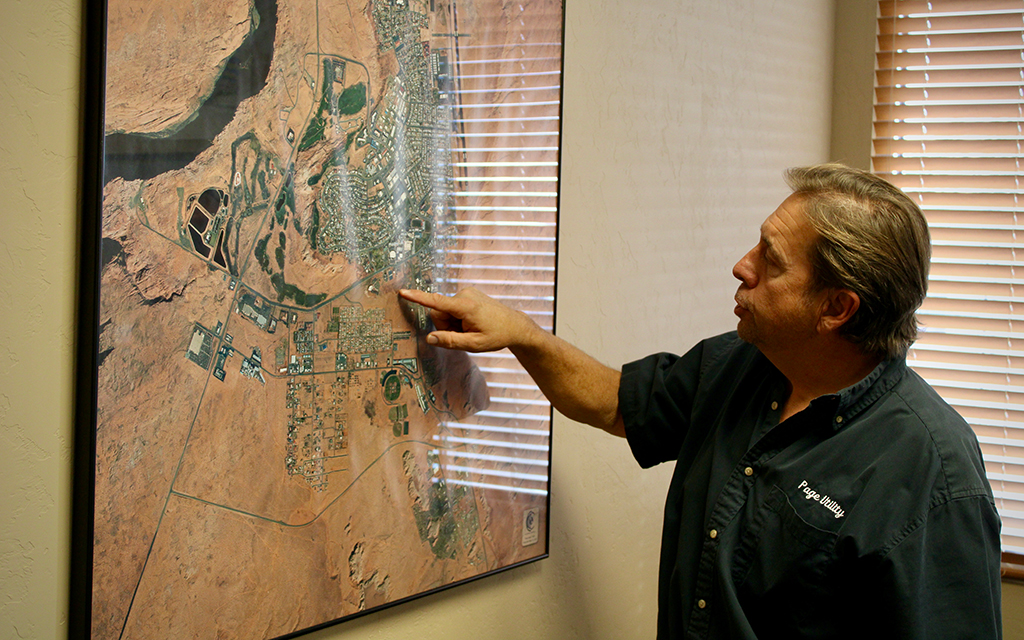PAGE – Tobyn Pilot took a few crunchy footsteps through the red dirt near the edge of a towering cliff. Pilot, an operator at the water plant in Page, pulled out a hefty collection of keys to unlock a tiny plywood shed just a few feet from the brink. The building is barely bigger than an outhouse, but it’s a pivotal part of keeping the taps flowing in this city of 7,500 people.
“The town’s water comes right through this shack,” Pilot said, revealing a small setup of pumps behind the creaking shed door. “Isn’t that crazy to think?”
Hundreds of feet below, the Colorado River calmly chugged along. It’s here, on the dusty precipice, that water from the river is redirected into homes, hotels and restaurants in this tourist town.
As the once-mighty Colorado shrinks in the hands of a changing climate, communities that rely on it are starting to feel the pinch. Many large cities in the Southwest are well-positioned to weather the growing crisis, but some smaller ones have a perilous front row seat as the diminished river threatens to cut off their water supply completely. Page is one of them.
Pilot pointed down to Glen Canyon Dam, a 700-foot-tall concrete behemoth that looms large in the background.
“There’s a pipeline that’s bored through the cliff of Glen Canyon,” Pilot said. “It comes to the edge, just past us here, and goes straight up into another pipeline that goes up to our water plant.”
That pipe brings water up from the river hundreds of feet below. But the system is under threat.
Page pulls its water from Lake Powell, the nation’s second-largest reservoir, which is held back by Glen Canyon Dam. Inside the dam, a pipe siphons water to Page as it passes from the reservoir to the river on the other side. Drought and steady demand have drained the reservoir to historic lows, putting Page’s drinking water system in jeopardy.
Bryan Hill, general manager of Page Utility Enterprises – the city’s water and electric provider – is tasked with keeping taps flowing in the cliffside city. He grapples with the historic missteps, both recent and decades-old, that make his job a tough one.
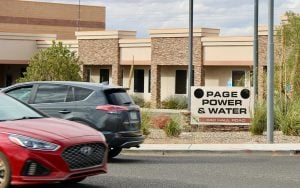
Page Utility Enterprises funded a project to modify a pipe inside Glen Canyon Dam to ensure that water keeps flowing if reservoir levels drop further. Now, it’s looking for federal funds to build a $46 million backup that would provide more long-term stability. (Photo by Alex Hager/KUNC)
“They never anticipated the lake actually dropping down to a level where Page was going to struggle to get water,” he said. “That just simply wasn’t anticipated. That’s why we’re scrambling to make a design mod down there now.”
Hill is referring to an ongoing rework of the pipes inside the dam. If the reservoir drops below Page’s current intake, water would flow through a set of backup pipes known as the “river outlet works.” Originally designed as a channel for extra water during high-flow times, those tubes, which are lower than the existing pass-through, could soon be the only way for water to make it through the dam. Without a fix, Lake Powell could have dropped low enough to cut off Page’s drinking water supply completely.
Inside the dam this fall, a team of welders has been working to put together new pipes that will connect Page to those river outlet tubes, making sure water still flows to the city even if the reservoir drops to an extremely low level. The new pipes also will help supply water to the neighboring LeChee chapter of the Navajo Nation.
This is shaping up to be a relatively easy fix. The modifications only cost $60,000 to $80,000, Hill said, and are slated to be finished in December.
“We’re proud of the Reclamation staff at the Glen Canyon Field Division for coming up with this cost efficient, relatively effortless solution,” said Bob Martin, the Bureau of Reclamation’s deputy power manager at the dam. “And it’s a positive step forward in maintaining the dependability of the area’s water supply during this time of increased risk.”
But a much bigger addition may be needed to give Page lasting peace of mind.
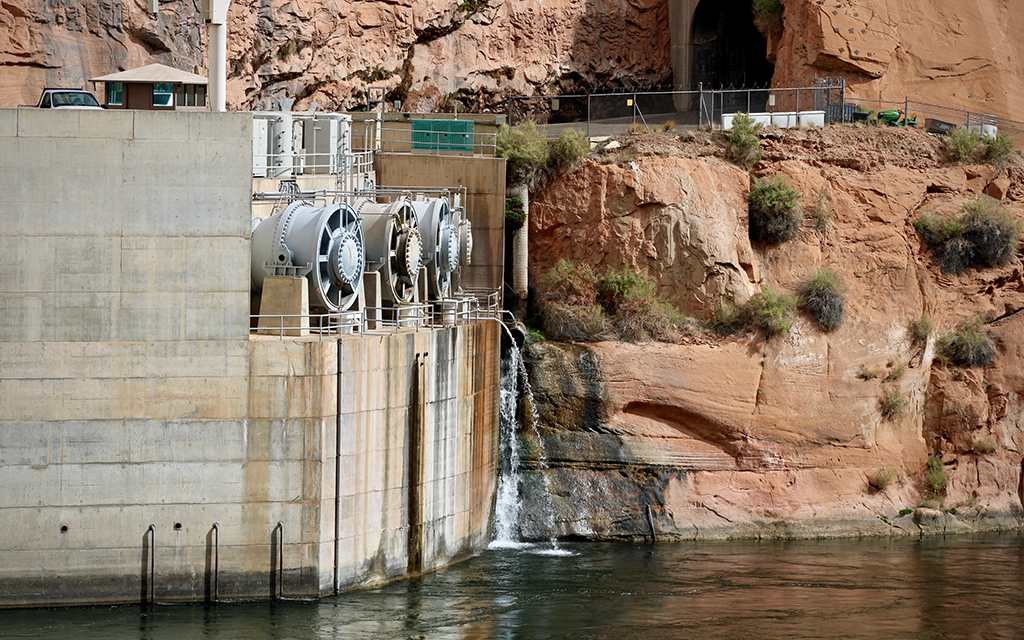
A set of four tubes known as the “river outlet works” could soon be the only way for water to make it through Glen Canyon Dam. Without changes to those tubes, Page’s drinking water supply would be cut off if Lake Powell continued to shrink. (Photo by Alex Hager/KUNC)
A ‘second straw’
Hill already knows what’s next on the to-do list: add redundancy. A lengthy 2004 report called for the construction of a “second straw,” another pipe upstream of the dam that would carry Colorado River water through hundreds of feet of rock and keep water flowing to Page should anything happen to the current intake within the dam.
But that would be an expensive project. The report, which was authored near the beginning of the two-decade-long megadrought that has thrust the Colorado River Basin into a supply-demand crisis, put a $46 million price tag on that second straw. Page won’t be able to scrape together that much through rate hikes, Hill said.
“You’re not going to get that kind of money out of 3,500 water customers,” he said. “That’s just not going to happen. People would just leave. The water would be so expensive, just to pay for the infrastructure.”
Hill thinks the federal government should be on the hook for that project.
Page is on the map only because of the dam and Lake Powell. The city originally was a housing camp for workers building and operating the dam in the late 1950s. Now, it’s a base camp for many of the 2 million annual visitors who come to the Glen Canyon National Recreation Area to boat around Powell and camp on its shores.
The dam was built and is operated by the Bureau of Reclamation, the same agency which published the report recommending a second straw.
“In the mid-70s,” Hill said, “(Reclamation) essentially said, ‘You know what, we really don’t want to run this town anymore. We want to run the dam, but we don’t want to run out of town,’ and flipped the keys to the kids and said, ‘Good luck.’”
Page has requested federal funding but hasn’t received it. This fall, water managers and utilities departments around the arid Southwest got a glimmer of hope that their projects might get a financial boost when $4 billion from the federal Inflation Reduction Act was designated for drought mitigation work in the Colorado River Basin. In the months since that announcement, Reclamation has set aside some of that money to pay farmers to conserve water, but also hinted that some will be used to upgrade outdated water infrastructure.
For their part, Reclamation officials say they’re still committed to work with Page and the Navajo Nation to offer assistance where appropriate.
“The city asked about Inflation Reduction Act funding and we explained that we are still early in the process and the plans for administering the IRA funding,” said Brandi Rose Worthington, a program support specialist with Reclamation. “There is not another meeting currently scheduled with the city to discuss funding, but we expect they’ll follow up with us.”
Hill argues that Page’s new $46 million straw would only use up a “thimble” of that $4 billion, and that Reclamation has a moral obligation to chip in.
“Without the federal government willing (Page) to be here, it wouldn’t be here,” he said. “And unless the federal government continues to will it to be here, it won’t be here in the future.”
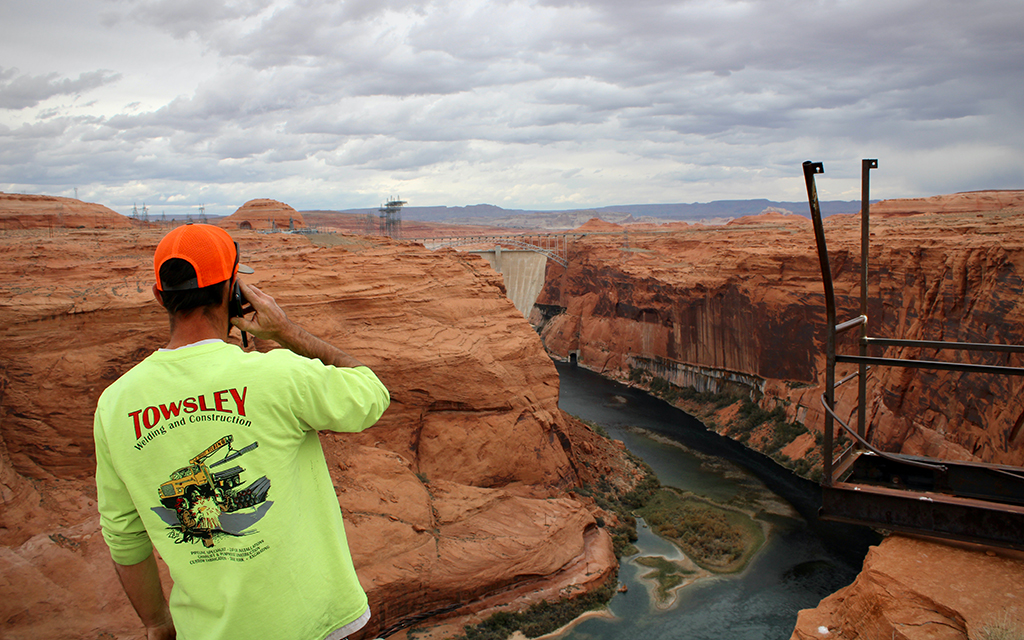
Tobyn Pilot of Page Utility Enterprises looks down toward Glen Canyon Dam. A pipe within the dam pulls water up to Page, but it needed modifications to keep operating amid dropping levels at Lake Powell. The city says it needs help funding a second pipe to provide longer-term water security. (Photo by Alex Hager/KUNC)
A tale of two city sizes
Page’s proximity to the river is an integral part of its identity. Residents are far closer to the Colorado than most of the more than 40 million people from Wyoming to Mexico who rely on its water. From that front row seat, Page residents also can see the challenges that come with sole dependence on it.
Kathryn Sorensen, director of research at Arizona State University’s Kyl Center for Water Policy, said Page’s situation is a cautionary tale for small towns and big cities across the Southwest.
“Climate change means that the flows of the Colorado River will continue to diminish,” she said. “So for those communities that are dependent on the Colorado River, they need to be looking around at their infrastructure, their alternative supplies and developing means to be able to continue safe, reliable deliveries at the tap.”
Sorensen is the former director of Phoenix’s water department, a city that gets about 40% of its water directly from the Colorado River.
Cities across the basin are working harder to stretch a finite supply of water. Las Vegas, Denver and Los Angeles are among those that have been forced to invest in new water supplies or incentivize water customers to limit their demands.
Meanwhile, supplies have only gone down. A warming climate has supercharged drought where it matters most – the high-altitude snowfields that account for the majority of the Colorado’s water. About 60% of the water in the river starts as snowmelt in Colorado, and a raft of environmental indicators show the state’s dry conditions are bad and getting worse, making that snow less reliable.
Agriculture accounts for 75% to 80% of water use in the Colorado River Basin, meaning that farmers, ranchers, and growing cities are all competing to hold on to their slices of a rapidly shrinking pie. River sharing is governed by a century-old document that water managers have been reluctant to amend. That has left the seven states that use the river in a high-stakes standoff, with growers and cities left to wait and see whether their allocations will shrink as a result of negotiations playing out among the states and the federal government.
At the same time, Sorensen said the Southwest’s urban and suburban areas have to come to terms with another challenge. Many of the region’s cities are “middle-aged, at best” and need to start paying for repairs to aging pipes and canals.
“There are very few communities, if any, who have really kept up with the necessary investment in aging infrastructure,” Sorensen said. “So I think you’re going to see pressures from both sides, and I think that that might be really humbling for some of our communities.”
Those fixes and additions of redundancy are expensive, which has forced some areas to roll the dice and forgo them. Sorensen said one-time federal bailouts won’t be enough to avert trouble, and cities will need to raise funds from within.
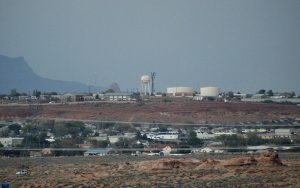
Water from Lake Powell is pumped to this treatment plant in Page. Utility officials say Page needs a multimillion-dollar backup pipe that would provide long-term security. The city is seeking federal help to fund that project. (Photo by Alex Hager/KUNC)
“Elected officials often are afraid to raise water rates because they’re afraid of reprisal at the next election,” she said. “But it is necessary to increase water rates so that you can keep up with aging infrastructure.”
Cities in the Southwest have not been entirely ignorant to the growing threats to water supplies. Some have pursued aggressive conservation and augmentation measures.
In and around Los Angeles, the Metropolitan Water District of Southern California is gearing up for a substantial investment in sewage treatment, that would clean up wastewater to drinkable standards and return it to city pipes.
Las Vegas, perhaps the basin’s poster child for urban conservation, has rolled out programs to replace water-intensive grass lawns with artificial turf and native plants. Faced with dropping levels in Lake Mead, the area’s water provider, the Southern Nevada Water Authority, built its own second straw in 2000, and then a third straw in 2015.
But those agencies are among the region’s largest and best-funded. While Los Angeles, Las Vegas and other populous cities are making headlines with forward-thinking projects to protect their water supplies against climate change, many smaller communities, like Page, often lack the money and staff to do the same.
“They just don’t have the kind of technical resources,” said Ellen Hanak, director of the Water Policy Center at the Public Policy Institute of California. “This is where being big means you’ve got some scale economies, and you can have a good-sized team to help you do your analysis and figure out what kind of investments you need to make. In the case of smaller ones, they just don’t have that. They also don’t have the scale economies from a financing standpoint either.”
Hanak said a long drought in the late 1980s and early 1990s served as a wakeup call for some cities, which invested in managing their demand and stretching existing water supplies with more efficient appliances and campaigns to encourage cutting back on water use in homes.
Cities are quick to flaunt the strides they’ve made in keeping taps flowing as populations boom. Some municipal water managers have made promises that they will continue to reduce per capita use, at the same time being candid about the fact that water conservation in cities can only make a small dent in the larger picture of the 246,000-square-mile basin.
Hanak says redundancy in water supply should be near the top of the list for cities looking to steel their infrastructure against climate change. Page’s need for a second means of acquiring water is not unique, and cities that were once able to draw from an extraordinarily reliable, abundant water source are often the ones that need to scramble the fastest as temperatures rise and dry conditions persist.
This story is part of ongoing coverage of the Colorado River, produced by KUNC in Colorado and supported by the Walton Family Foundation. KUNC is solely responsible for its editorial coverage.
